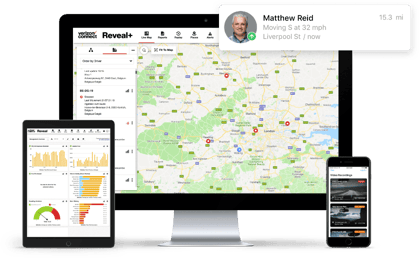9 Secrets to Reducing your Fleet Expenses
As a fleet owner, your day-to-day costs can quickly add up. What you don’t know is there are further hidden, expensive...
Read more
Tachographs are essential technology in fleet management, helping keep drivers and the haulage companies they work for compliant with drivers’ hours rules. As of May 2006, newly registered vehicles must be fitted with a digital tachograph to help collect data more efficiently – there are some exemptions, however. Unfortunately, although tachographs help monitor the situation on the ground, they don’t necessarily prevent those tachograph infringement codes from popping up in driver reports.
We’ll have a look at the most common tachograph rules and infringement codes, along with tachograph infringement fines and penalties. We’ll also look at solutions to help counter non-compliance which could improve your business and keep your fleet on the road.
While the UK was part of the EU, fleets operated by UK businesses were subject to at least seven coordinated control weeks each year in accordance with article five (5) of EC 2006/22, which were managed by organisations like ROADPOL (European Road Policing Network).
According to figures from ROADPOL (European Road Policing Network), of the 210,365 HGVs that were checked, 63,567 violations were found and the onward journey had to be prohibited until the proper condition of the vehicles or load had been restored on 221 occasions.
The most common violation codes (according to ROADPOL) for tachographs in 2022 were related to the following types of offences:
In detail:
This can have serious consequences, both for the driver and the employer and the tachograph fines can amount to quite a sum. Furthermore, for certain infringements, non-compliance can result in criminal charges and further actions. Let’s take a look at the fines and what tachograph solutions Reveal can offer to help combat non-compliance.
In the UK, tachograph infringement penalties are split into different levels. The maximum tachograph fines are contained within Part VI of the Transport Act 1968 – there are level 4 fines and level 5 fines, which are higher. Let’s take a closer look at what these are.
Level 4 fines include:
The fines for level 4 are capped at a maximum of £2,500. However, it should be noted that this is a cap for each tacho fine. Cases with multiple level 4 infringements may face a maximum fine per infringement.
Level 5 fines include:
The fines for level 5 are capped at a maximum of £5,000. However, as with level 4 fines, this figure is a cap for each tacho fine. Cases with multiple level 5 infringements may face a fine per infringement.
There are also fines which deal with the tampering of tachographs. These incur a level 5 fine (£5,000), but also mean that, on indictment, there may be a two-year imprisonment. Tachograph manipulation penalties are bad news and are classified as:
In the case of a tacho infringement, there is no clear-cut answer as to who is responsible. It can be either the driver themselves, or the employer. Where culpability lies is dependent on a few factors, such as how a driver performs their work and why a fine is imposed. Should a driver refuse to produce tachograph information, it is reasonable to think that this would then be the driver’s responsibility, whereas if a company vehicle wasn’t fitted properly with a tachograph in the first place, the responsibility may be that of the company’s.
However, the situation is unfortunately a bit murky and is often dealt with on a case-by-case basis. The take-away is that both drivers and their companies can be held liable for the tachograph infringements, making a thorough and reliable tachograph system all the more important.
Digital solutions in the form of telematics can help simplify the situation for your company. You may already have equipped your vehicles with GPS tracking, which is a great step in keeping track of your fleet. However, keeping track of driver data can be time consuming, especially when you have other things to deal with in your business.
Digital tachograph software, such as the one offered by Verizon Connect, can help monitor drivers’ hours and their rest periods. However, it can also help automate the process of recording and downloading tachograph data properly, taking some of the weight of administrative hassle off your shoulders. This helps you manage compliance and helps your drivers get the weekly rest they require. The Verizon Connect digital tachograph software is updated in near real-time, meaning you have all the necessary information at your fingertips, and you don’t need to request an upload from your driver. Verizon’s digital tachograph software allows for the remote download of tachograph data, meaning that your drivers can focus on the task at hand and keep their attention on the road.
Tags: All




Find out how our platform gives you the visibility you need to get more done.
As a fleet owner, your day-to-day costs can quickly add up. What you don’t know is there are further hidden, expensive...
Read moreVerizon Connect Reveal tracks the fleet data that can have a big impact on your business. These are things like where...
Read moreAt Verizon Connect, we can only provide the highest possible level of service to fleet managers and business owners by...
Read moreReveal tracks the fleet data that can have a big impact on your business. These are things like where your vehicles are...
Read more